Euro-to-Dollar Rate Eyes White House Tariff Threat after Trade Data Shows Exports Falling
- Written by: James Skinner
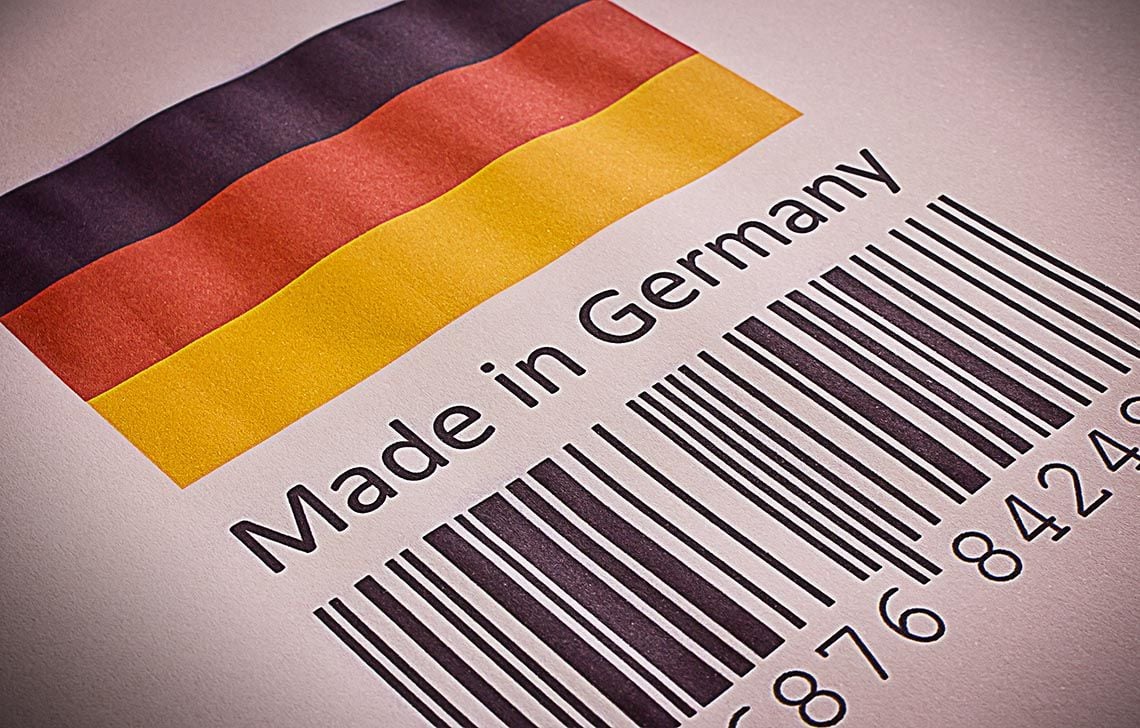 © Open Water, Adobe Stock
© Open Water, Adobe Stock
- EUR weakens cedes ground to rivals amid heightened trade tariff threat.
- Eurostat data shows EUR exports falling as White House eyes EU cars.
- Auto report could spell U.S.-EU tariff fight, weighing on growth and EUR.
The Euro-to-Dollar rate weakened Friday and the U.S. greenback advanced broadly as financial markets kept one eye on the White House while responding to official data that showed Eurozone exports shrinking in December.
Eurostat said Friday the Eurozone trade surplus shrank to €15.6 billion in December, down from an upwardly-revised €15.8 billion previously, after imports remained stable for the month while exports fell. That's down from €24.5 bn in December 2017.
Exports were down -0.1% at €192.2 bn in December while imports were unchanged at €176.6 bn. For the year overall the Eurozone trade in goods surplus was €194.2 bn, down from €234.9 bn in the 2017 year.
"The EZ trade surplus has come down significantly in the past 12 months from its trend of +€20B between 2015 and 2017, but we doubt that it will fall much further in the first half of the year. A further escalation in the trade conflict between China and the U.S. and a hard Brexit are the main risks," says Claus Vistesen, chief Eurozone economist at Pantheon Macroeconomics.
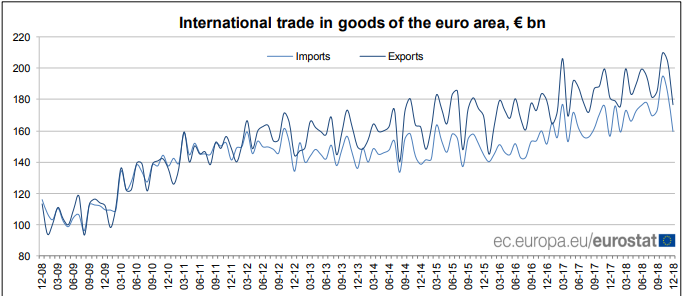
Above: Eurozone import and export growth as measured by Eurostat.
"The months ahead remain very uncertain, meaning that exports are likely to dip if downside risks materialise," warns Bert Colijn, an economist at ING Group, before citing uncertainty over the Brexit process and an absence of progress in trade talks between the U.S. and China as significant risks to the outlook.
Trade balance data measures the difference in value between a nation's imports and its exports. Currency markets care about it because the data provides insight into supply and demand of a currency in the "real economy", while also giving a steer on the likely pace of GDP growth in a given period.
The size and trajectory of a trade surplus or deficit is important for economic growth because imports are a subtraction in the calculation of GDP, while exports represent a credit to the value of economic output. As a result, rising exports and, or, falling imports can help boost the economy.
"The small decline in nominal exports in December masks a strong performance for the quarter, which is encouraging given the significant downside risks in the economy," says Colijn.
Colijn says he is already seeing signs that a recovery in Eurozone trade and economic data, from depressed 2018 levels, could be in the pipeline for the months ahead and he's not alone either because analysts at Nordea Markets said something similar Friday too.
Nordea cited the Organization for Economic Cooperation and Development "leading indicator" as grounds for thinking an economic rebound is on the way. The OECD indicator is pointing to the current downturn in European growth running out of steam in around 4-5 months time.
But exactly what does happen next in European economies will depend in no small part on what the White House, European Commission, Chinese officials and UK Brexit negotiators do about their various predicaments next.
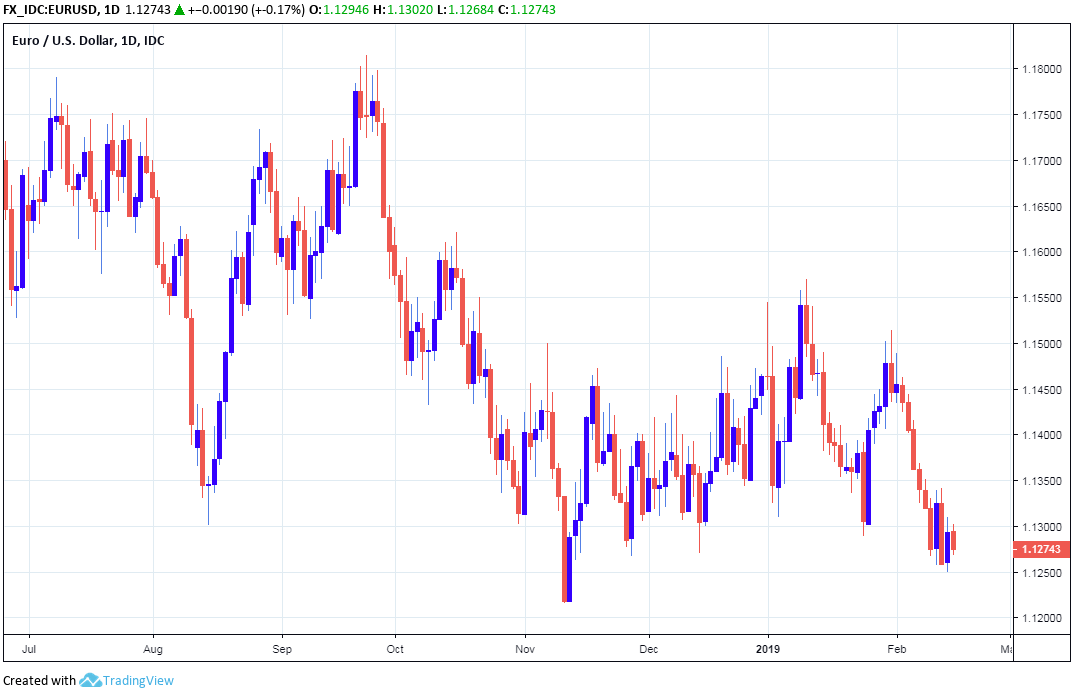
Above: Euro-to-Dollar rate shown daily intervals.
The Euro was quoted -0.07% lower at 1.1275 against the Dollar Friday while the Euro-to-Pound rate was -0.32% lower at 0.8796. Both exchange rates have declined this year, by -1.6% and -2.18% respectively.
"We suspect that a fresh downdraft in risk appetite could see both a strong USD and perhaps even stronger JPY perhaps most heavily felt in crosses like CADJPY and AUDJPY," says John Hardy, chief FX strategist at Saxo Bank. "But EURJPY is another candidate, given the gathering clouds over Europe after Germany showed no growth in Q4."
Hardy says EUR/USD is "trying mightily to break the range lows" at 1.1215. Bearish price action comes in a session where the Dollar is riding high, supported by unease over the outlook for international trade relations and concerns that President Donald Trump could announce a "state of emergency" in order to get funding for his proposed wall along the Mexican border.
"The market mood sits on a cautious state, hoping for some form of a trade truce. But at the same time quite anxious on each passing headline. Since the start of the year, this has seen the market reverse some of the early moves and yet an established trend is lacking. That keeps the USD in the driver's seat against the low-yielders," says Mazen Issa, a strategist at TD Securities.
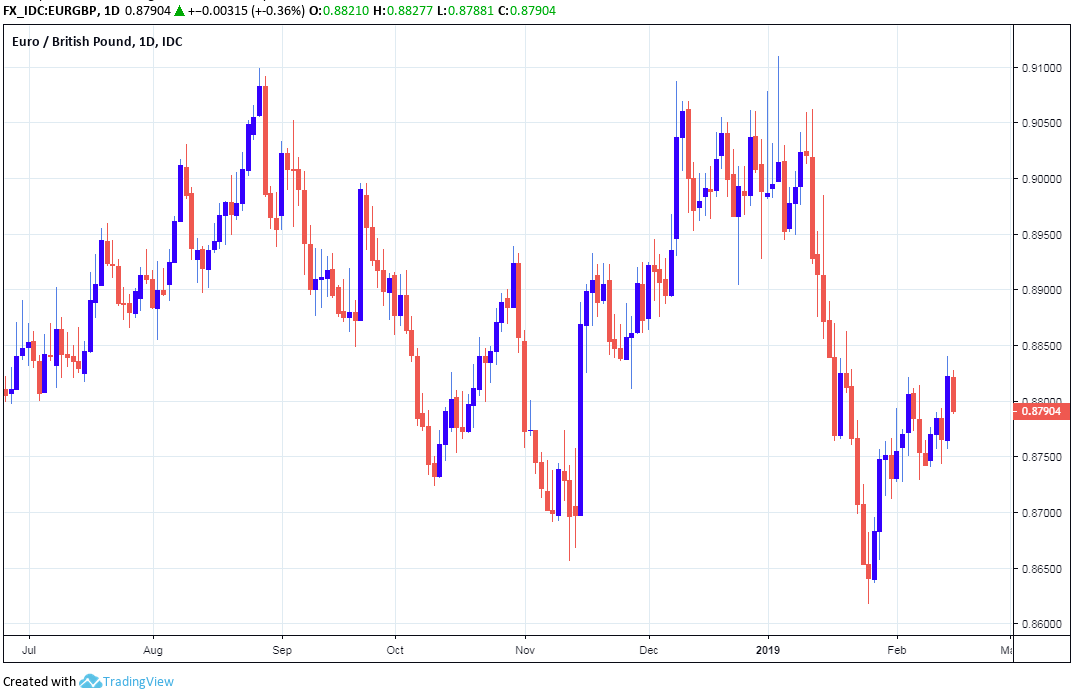
Above: Euro-to-Pound rate shown at daily intervals.
Friday's data comes as markets have one eye on the White House ahead of an eagerly awaited decision on the federal budget and border wall, as well as before a Sunday deadline for the U.S. Commerce Department to submit a section 232 report to the President outlining what threat European car exports might present to national security.
"Given the focus on the US-Chinese negotiations, the coverage of auto tariffs has drifted into the shadows," says Martin Enlund, a strategist at Nordea Markets. "Trump used exactly such a report on steel and aluminium to issue an executive order on metal tariffs."
The Commerce Department previously labelled imports of steel and aluminium from a range of countries including Canada and European Union members as threats to security, which provided President Donald Trump with the pretext required for him to impose tariffs on imports of steel into the U.S.
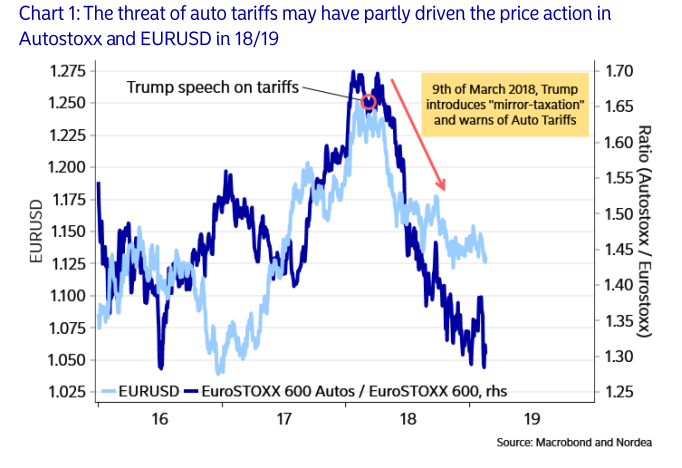
Above: European automotive firm stock prices and Euro-to-Dollar rate. Source: Nordea Markets.
Fears are that the report will somehow make the case that car imports are a threat to national security, enabling Trump to target European automotive manufacturers with tariffs that could be as high as 25%. Such a move could deliver a damaging-if-not-deadly blow to an already-struggling Eurozone.
Eurozone GDP growth fell to 1.8% last year, from 2.4% previously, while quarterly growth halved from 0.4% to 0.2% for the second half of the year. The German economy stalled with 0% growth for the final quarter, after contracting by -0.2% in the third quarter.
This already knocked the European Central Bank (ECB) off an earlier course toward "normalisation" of its interest rate structure and withdrawal of the extraordinary stimulus provided in the aftermath of the Eurozone debt crisis.
Anything that further weakens the economy will undermine the outlook for inflation and keep the ECB at bay for even longer, which wouldn't be a positive development for the currency because in the face of higher rates elsewhere in the world, the ECB's policy is depressing investor appetite for the Euro.
Time to move your money? Get 3-5% more currency than your bank would offer by using the services of foreign exchange specialists at RationalFX. A specialist broker can deliver you an exchange rate closer to the real market rate, thereby saving you substantial quantities of currency. Find out more here.
* Advertisement




